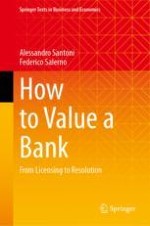2023 | OriginalPaper | Chapter
Valuing a Bank in Going Concern
Authors : Alessandro Santoni, Federico Salerno
Published in: How to Value a Bank
Publisher: Springer International Publishing
Activate our intelligent search to find suitable subject content or patents.
Select sections of text to find matching patents with Artificial Intelligence. powered by
Select sections of text to find additional relevant content using AI-assisted search. powered by
